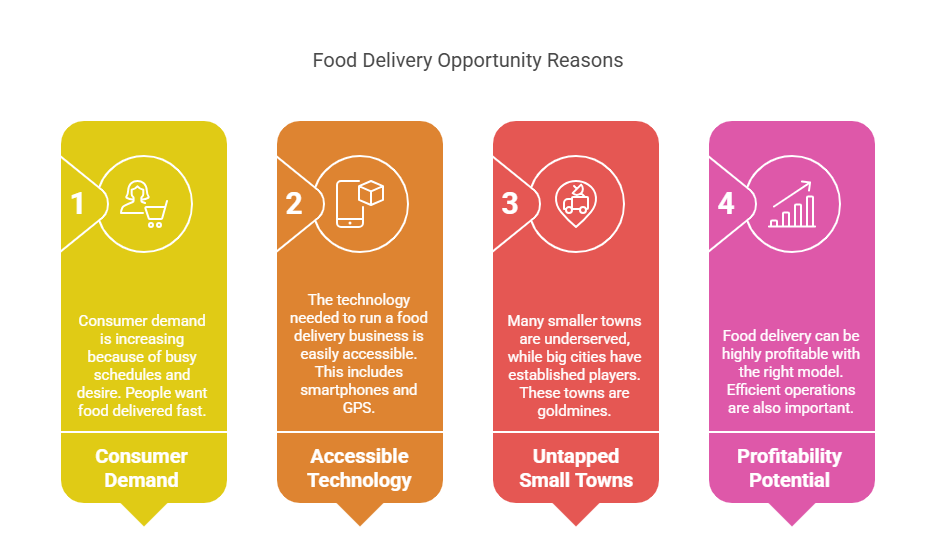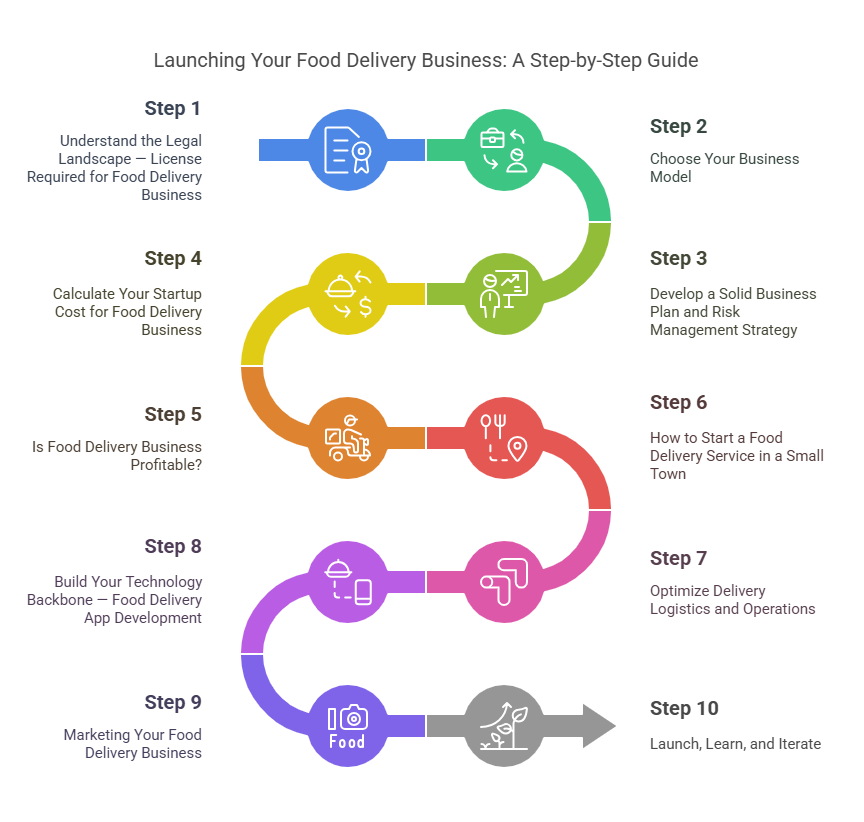We are not at the start of something. We are already in it. The world of food delivery isn’t a trend knocking on the door. It’s the door itself, wide open, inviting entrepreneurs to step inside. The way we order, receive, and enjoy food has changed forever. And if you’re reading this, you’re probably thinking: How do I start my own online food delivery business?
Maybe you’re in a small town wondering if it’s even worth it. Maybe you’re curious about the startup costs, the licenses you need, or if this business is profitable at all. Or maybe you’re dreaming of building your own food delivery app but don’t know where to begin. Whatever your situation, this guide is designed to answer all those questions and more — in a way that feels like a conversation, not a lecture.
Why Start an Online Food Delivery Business Now?

Before diving into the “how,” let’s talk about the why. The food delivery market has exploded globally, driven by convenience, changing lifestyles, and technology. Here’s why it’s a golden opportunity:
- Consumer demand is skyrocketing: Busy schedules and the desire for variety mean people want food delivered fast and fresh.
- Technology is more accessible than ever: From smartphones to GPS tracking, the tech stack needed to run a food delivery business is within reach.
- Small towns are untapped goldmines: While big cities have established players, many smaller towns remain underserved.
- Profitability potential: With the right model and efficient operations, food delivery can be highly profitable.

Step 1: Understand the Legal Landscape — License Required for Food Delivery Business
Before you start delivering meals, you need to clear the legal hurdles:
- Business registration: Register your business entity according to local laws.
- Food safety and health licenses: Depending on your country or state, you may need permits for food handling, hygiene certification, and safety inspections.
- Food delivery license: Some regions require a specific license for food delivery services.
- Vehicle permits and insurance: If you have your own delivery fleet, ensure vehicles are insured and comply with transport regulations.
- Tax compliance: Set up GST/VAT and other applicable taxes.
- Insurance coverage: Obtain general liability insurance, vehicle insurance, and workers’ compensation to protect your business and employees.
Tip: Consult a local legal expert to ensure you don’t miss any critical licenses or permits.
Step 2: Choose Your Business Model
There are three popular models in the food delivery space:
- Aggregator Model: You act as a platform connecting customers with multiple restaurants (like Uber Eats or Zomato).
- Single Restaurant Delivery: You partner with one or a few restaurants and manage deliveries exclusively.
- Hybrid Model: Own some restaurants while also aggregating others.
Each has pros and cons in terms of startup cost, complexity, and control. For small towns, starting with a single or hybrid model might be easier.
Step 3: Develop a Solid Business Plan and Risk Management Strategy
A clear business plan is your roadmap — it helps you anticipate challenges and seize opportunities.
- Market research: Identify your target audience, competitors, and market gaps.
- Unique Selling Proposition (USP): What makes your service different? Faster delivery? Healthier options? Local favorites?
- Pricing strategy: Decide your commission rates, delivery fees, and restaurant pricing.
- Risk management: Plan for delivery delays, tech glitches, food safety issues, and customer complaints.
Step 4: Calculate Your Startup Cost for Food Delivery Business
Knowing your financial requirements upfront can save headaches later. Key expenses include:
- Technology development: Building an online food delivery app or website can range from $10,000 to $100,000+, depending on features.
- Licenses and permits: Varies by location but budget a few hundred to a few thousand dollars.
- Marketing and branding: Website, social media, promotions, and local advertising.
- Delivery logistics: Hiring drivers, vehicle maintenance, fuel, and delivery management.
- Operational costs: Customer support, packaging, and office expenses.
- Packaging and sustainability: Invest in quality, eco-friendly packaging to maintain food quality and appeal to environmentally conscious customers.
Pro tip: Partnering with a software development company like Enacton can optimize your tech spend by delivering tailored, scalable solutions without unnecessary extras.
Step 5: Is Food Delivery Business Profitable?
The short answer: Yes, but it depends.
Profitability hinges on:
- Order volume: More orders mean better economies of scale.
- Commission and pricing strategy: Balancing restaurant commissions and delivery fees.
- Operational efficiency: Optimizing delivery routes and minimizing wait times.
- Customer retention: Repeat customers are cheaper than new ones.
- Technology: A smooth app experience reduces order errors and boosts customer satisfaction.
With smart planning and the right tech, food delivery can be a lucrative business — especially in underserved markets.
Step 6: How to Start a Food Delivery Service in a Small Town
Small towns might seem like a challenge, but they’re often your best bet for success:
- Build local partnerships: Connect with local restaurants hungry for delivery solutions.
- Understand local preferences: Tailor your menu options and delivery times.
- Community engagement: Sponsor local events or offer special discounts to build trust.
- Leverage word-of-mouth: Happy customers in small towns talk — a lot.
- Flexible order channels: Offer phone, WhatsApp, or social media ordering to accommodate less tech-savvy customers.
Step 7: Optimize Delivery Logistics and Operations
Efficient delivery is the backbone of your business:
- Delivery area and timing: Define your delivery zones and operating hours based on demand patterns.
- Driver recruitment and training: Hire reliable drivers and train them on customer service and food safety.
- Route optimization: Use GPS and route-planning tools to minimize delivery time and fuel costs.
- Kitchen readiness: Ensure your partner restaurants or your own kitchen can handle increased order volume without compromising quality.
- Packaging: Use insulated, secure, and sustainable packaging to keep food fresh and intact.
Step 8: Build Your Technology Backbone — Food Delivery App Development
Technology is the heart of your online food delivery business. Your app or platform should:
- Be user-friendly for customers, restaurants, and delivery drivers.
- Offer real-time order tracking and notifications.
- Support multiple payment options with secure gateways.
- Include driver management and dispatching tools.
- Provide analytics dashboards to monitor performance and customer behavior.
Custom food delivery app development or online food delivery app development is a smart investment. Off-the-shelf solutions may limit your growth and customization.
Why Partner with Enacton for Your Food Delivery Software?
At Enacton, we don’t just build apps — we build your business’s digital heartbeat. With deep expertise in foodtech software development, we help food delivery startups and established players alike by providing:
- Custom food delivery app development tailored to your business model.
- Integrated restaurant and driver management systems.
- Real-time tracking and analytics dashboards.
- Seamless payment gateway integration.
- Scalable architecture that grows with your business.
Our approach is collaborative and transparent — we listen, understand your challenges, and deliver solutions that work in the real world.
Step 9: Marketing Your Food Delivery Business
Great food and fast delivery aren’t enough without customers. Here’s how to get noticed:
- SEO and Content Marketing: Optimize your website and blog to rank for keywords like “license required for food delivery business” or “startup cost for food delivery business.”
- Social Media Engagement: Use Instagram, Facebook, and local groups to showcase your offerings.
- Influencer Collaborations: Partner with local food bloggers or influencers.
- Referral Programs: Encourage customers to bring friends with discounts or freebies.
- Local Advertising: Flyers, radio ads, or sponsoring community events.
Step 10: Launch, Learn, and Iterate
Launching your online food delivery business is just the beginning. Use customer feedback and data analytics to:
- Improve app usability.
- Optimize delivery routes.
- Expand your restaurant partnerships.
- Add new features like contactless delivery or subscription meal plans.
Starting an online food delivery business is a thrilling journey with immense potential. It requires vision, planning, legal compliance, smart investment, and most importantly, the right technology partner.
If you want to build a food delivery platform that stands out, runs smoothly, and scales effortlessly, Enacton is here to help you turn your vision into reality.
Ready to start your food delivery business the right way?
Explore how our custom software solutions can power your success. Visit Enacton Foodtech Software Development and let’s create the future of food delivery together.
